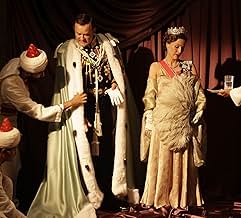Der letzte Vizekönig von Indien, Lord Mountbatten, wird beauftragt, den Übergang von Britisch-Indien zur Unabhängigkeit zu überwachen und muss sich bald mit den vielen Konflikten auseinander... Alles lesenDer letzte Vizekönig von Indien, Lord Mountbatten, wird beauftragt, den Übergang von Britisch-Indien zur Unabhängigkeit zu überwachen und muss sich bald mit den vielen Konflikten auseinandersetzen, die zwischen den verschiedenen Parteien angesichts dieser monumentalen Veränderung... Alles lesenDer letzte Vizekönig von Indien, Lord Mountbatten, wird beauftragt, den Übergang von Britisch-Indien zur Unabhängigkeit zu überwachen und muss sich bald mit den vielen Konflikten auseinandersetzen, die zwischen den verschiedenen Parteien angesichts dieser monumentalen Veränderung aufbrechen.
- Auszeichnungen
- 1 wins total
- Duleep Singh
- (as Jaskiranjit Deol)
Empfohlene Bewertungen
Gillian Anderson gives a vivid portrayal of Lady Edwina Mountbatten, terribly 'posh' but genuinely concerned for the displaced natives during the violent transition. Hugh Bonneville, still trapped in his Downtown Abbey character, is rather wooden as Lord 'Dickie' (who was probably a bit wooden too). There is no hint of the much-gossiped- about affair between Lady M and Mr Nehru and likewise no hint that his lordship may have been an acquaintance (if not quite a Friend) of Dorothy. We see enough of Nehru and Jinnah to understand what was at stake in 1947 but for some reason Gandhi is largely written out of this screenplay.
To give the movie a bit more box-office appeal there is a Mills & Boon romance between two of the staff in the Viceroy's House, a beautiful Muslim secretary and a Hindu valet (also rather lovely). This soap-opera element brings unavoidable echoes of the (enormously superior) Jewel in the Crown and a dash of Upstairs, Downstairs which was one of the many addictive pleasures of Downton.
There's not a lot that's wrong with Viceroy's House and much to enjoy: the costumes, the spectacle, the splendour that is colonial Delhi. The movie does offer a 'History-lite' version of the birth of a nation. I remind myself that this is exactly what GONE WITH THE WIND did with the American Civil War - but (forgive me, please) I've never been a great admirer of GWTW.
Let's start on the plus side, however, with the visuals. If there's one thing that this film does really well, it's capture the vibrant real-life locations of both the Viceroy of India's residence and the streets of India. Filmed entirely on location, the grandeur of the main stage is fantastic to look at, whilst the costume design that ranges from Viceroy Mountbatten's decorated military attire to the colourful uniforms and dress of the Indian people is central to the film's more pleasant atmosphere.
Another thing that helps to make this a pleasant watch is the performances. The screenplay doesn't really bring any depth of character to any of the main players, and I can't really say any of the lead actors did much to bring that about either, however the likes of Hugh Bonneville and Gillian Anderson as Lord and Lady Mountbatten, as well as Manish Dayal and Huma Qureshi in supporting roles, give this a very confident and classy atmosphere that stands up well on screen.
However, that's where the positives start to end. Although I can say that the film does a good job at telling the facts of the end of British rule in India, and is interesting for anyone who wants an education into the time period, it doesn't really manage to do it with any sort of vigour or passion.
Throughout, this feels like a collection of good actors reading out the final chapter of a school history textbook about British India in the real locations. It's interesting to see, but it's by no means a cinematic masterclass.
That's where the directing and writing should have come in to make something more memorable out of the history. Unfortunately, the screenplay offers very little in the way of emotional or dramatic character depth, which means that the conflicts that arise don't have any sort of power, and the directing is more focused on the visual aspect of the film, rather than giving it a solid pace and riveting atmosphere.
And that remains the case for almost the entire movie, save for the very final act. If there's one part of Viceroy's House that does the gravity of the history justice, it's right at the end, and features the only few minutes of the film that are both informative and emotionally engaging.
On the whole, I had a nice enough time with Viceroy's House. It's not as dramatic nor passionate a retelling of India's independence as it definitely should be, and with average writing and directing, there's not much to really grab onto. However, with some delightfully vibrant visuals from start to finish, as well as some good central performances, this is a pleasant watch.
Wusstest du schon
- WissenswertesThis is the first movie released in British cinemas (different screens and different film prints) in two languages: English and Hindi.
- PatzerA huge red carpet is rolled down a stone staircase just as the Viceroy's carriage is arriving. It would have been done much earlier, due to the time it takes to fold the heavy carpet into each step.
- VerbindungenFeatured in Film '72: Folge #46.7 (2017)
Top-Auswahl
- How long is Viceroy's House?Powered by Alexa
Details
- Erscheinungsdatum
- Herkunftsländer
- Offizielle Standorte
- Sprachen
- Auch bekannt als
- Viceroy's House
- Drehorte
- Rashtrapati Bhavan, Delhi, Indien(Viceroy's House)
- Produktionsfirmen
- Weitere beteiligte Unternehmen bei IMDbPro anzeigen
Box Office
- Budget
- 8.500.000 $ (geschätzt)
- Bruttoertrag in den USA und Kanada
- 1.105.717 $
- Eröffnungswochenende in den USA und in Kanada
- 48.134 $
- 3. Sept. 2017
- Weltweiter Bruttoertrag
- 11.568.633 $
- Laufzeit
- 1 Std. 46 Min.(106 min)
- Farbe
- Sound-Mix
- Seitenverhältnis
- 2.35 : 1











































